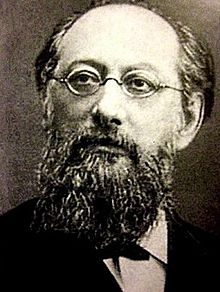Mark Natanson
Mark Natanson | |
|---|---|
 | |
| Born | Mark Andreyevich Natanson 6 January 1851 |
| Died | 29 July 1919 (aged 68) |
| Occupation(s) | Revolutionary, political activist |
| Family | Alexander Berkman (nephew) |
Mark Andreyevich Natanson (
Early life
Natanson was born in 1850 in
Populist movement
Together with his first wife, he was one of the organizers of the populist
In 1876, Natanson returned to
, where he got a job on the local railway.After 'Land and Liberty' split, he once again began work on the unification of disparate revolutionary circles. He set himself the goal of uniting the populist, social democratic and liberal movements in the Russian liberation movement. In September 1893, at the constituent congress in Saratov, a single party, '
When a shipyard was organised for the construction of a ferry crossing on Lake Baikal, the Corps of Ship Engineers needed an experienced and honest accountant, and Natanson took the job. His merits in organizing the construction are confirmed by the fact that on June 17, 1899, at the gala dinner in honor of the launch of the icebreaker "Baikal", there was a toast pronounced in honor of the political exile.
People's Rights Party
After his release he returned to European Russia and became active in Saratov, where in 1893, he founded the party People's Rights Party (Partiia Narodnogo Prava).[3] Historian Shmuel Galai has argued that "for the first time in the annals of Russian parties, it declared organized public opinion to be the main weapon in the struggle against autocracy," in contradistinction to peasant revolt, general strike, or terror.[4] However, the People's Rights Party proved to be a short-lived venture, as in 1894, Natanson was arrested again and banished to eastern Siberia for ten years.[3] Natanson remained an active revolutionary even in Siberian exile, maintaining the party treasury and coordinating various organisational tasks.[3]
Upon returning from exile, he lived in
The tactical position adopted by the SRs represented a compromise between the rural agitation favoured by
Natanson still held a reserved position in relation to the party's terrorist tactics. In 1906, he was an opponent of the assassination of
Years of exile
When the
Founder of Left SRs
After the February Revolution broke out, Natanson returned to Russia through German territory "in a sealed wagon", as did Lenin.[10][11] He became one of the most prominent leaders of the left wing of the SRs, which became increasingly disenchanted with the Provisional Government and with Alexander Kerensky and sharply criticised the defensive position of the SR central committee. Natanson advocated the "deepening" of the revolution, the transfer of all land to peasants and of power to the soviets. Natanson and the "Left SRs" supported the October Revolution, which caused a split in the Socialist Revolutionary Party. In November 1917, he initiated the creation of the party of Left Socialist-Revolutionaries. At the first Left SR congress, he was elected to the Presidium, and then to the Central Committee of the new party.
The Left SRs rejected the
Death
In July 1919, Mark Natanson died in Switzerland from complications of thromboembolism and purulent pneumonia after a surgical operation for a prostate tumor. He is buried in Bern.
Footnotes
- ^ Kropotkin, Peter (1899). Memoirs of a Revolutionist. Retrieved April 13, 2020.
- ^ "Nathanson Mark" (in Russian). Shorter Jewish Encyclopedia.
- ^ a b c d e Mandred Hildermeier, The Russian Socialist Revolutionary Party Before the First World War. New York: St. Martin's Press, 2000; pg. 382.
- ^ Shmuel Galai, The Liberation Movement in Russia, 1900-1905. Cambridge, England: Cambridge University Press, 1973; pg. 64.
- ^ Krupskaya, N.K. (1979). "Memories of Lenin". Memoirs of V.I. Lenin.
- ^ Khazan, V. (2008). Pinchas Rutenberg. From terrorist to Zionist. Gesharim.
- ^ Rutenberg, Pinchas (1925). "The assassination of Gapon". Leningrad.
- ^ Nikolaevsky, B. (1991). "The story of a traitor (Azef)" (in Russian). Retrieved April 13, 2020.
- ^ Burtsev, Vladimir (1989). In pursuit of provocateurs. Contemporary.
- ^ Wieczynski, Joseph L., ed. (1976). The Modern Encyclopedia of Russian and Soviet History. Vol. 24. Academic International Press. p. 79.
- ^ a b Chernov, V.M. (2007). "In the party of socialist revolutionaries: Memories of eight leaders" (in Russian).
Further reading
- The Great Soviet Encyclopedia, 3rd Edition, Moscow, 1970–1979.
- Aptekman, O. V. “Dve dorogie teni: Iz vospominanii o G. V. Plekhanove i M. A. Natansone kak semidesiatnikakh.” Byloe, 1921, no. 16.
- Figner, V. N. “M. A. Natanson.” Poln. sobr. soch. vol. 5. Moscow, 1932.
- Itenberg, B. S. Dvizhenie revoliutsionnogo narodnichestva. Moscow, 1965.
